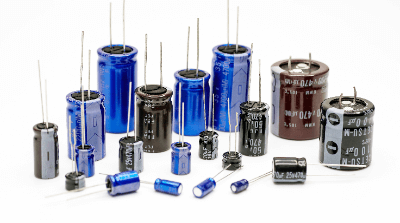What Is an Electrolytic Capacitor?
 An electrolytic capacitor is a capacitor that uses an oxide film of aluminum or tantalum as a dielectric.
An electrolytic capacitor is a capacitor that uses an oxide film of aluminum or tantalum as a dielectric.
The general characteristics of an electrolytic capacitor are its high capacitance and voltage polarity. Electrolytic capacitors are classified into liquid (wet) and solid electrolyte types, as follows:
1. Liquid Electrolyte
- Aluminum electrolytic capacitor (wet)
- Tantalum electrolytic capacitor (wet)
2. Solid Electrolyte
- Manganese dioxide-based solid electrolytic capacitor
- Functional polymer electrolytic capacitor
- Organic semiconductor-based solid electrolytic capacitors
- Electric double layer capacitors (super-capacitors) are also sometimes included in the electrolytic capacitor category
Uses of Electrolytic Capacitors
Electrolytic capacitors are used as smoothing circuits in power supplies. They are also suitable for use as decoupling capacitors and backup capacitors.
Tantalum electrolytic capacitors are particularly suitable for decoupling capacitors because of their high capacitance and low impedance over a wide frequency band.
Principle of Electrolytic Capacitors
Using an aluminum electrolytic capacitor as an example, the mechanism of an electrolytic capacitor is described below.
Aluminum electrolytic capacitors use an oxide film (Al2O3) formed on the anode metal surface by electrochemical surface treatment as a dielectric. The surface of the aluminum foil is etched to form irregularities on the surface, effectively expanding the surface area and achieving a large capacitance.
The electrolyte is filled between the electrodes to extend the cathode, but since the electrolyte gradually leaks out of the package and evaporates over a long period, a decrease in capacitance over time is inevitable. This is especially noticeable at high temperatures, so to extend the life of the product, it is necessary to avoid increases in ambient temperature.
The relative dielectric constant of aluminum oxide formed on the surface of aluminum foil is 7~10, and its dielectric breakdown voltage is 500kV/mm or higher. That is, aluminum electrolytic capacitors utilize the depletion layer capacitance of the reverse polarity of this diode, but because they utilize this reverse polarity, the applied voltage of aluminum electrolytic capacitors is limited to one direction. This is the reason why reverse voltage cannot be used.
Tantalum electrolytic capacitors use tantalum pentoxide as the dielectric and manganese dioxide as the electrolyte. Since the electrolyte is solid, leakage does not occur. Tantalum electrolytic capacitors have an advantage over aluminum electrolytic capacitors in terms of life expectancy.
Types of Electrolytic Capacitors
All types of electrolytic capacitors are characterized by their high capacitance, but there are applications that take advantage of the characteristics of each type.
1. Aluminum Electrolytic Capacitor
Aluminum electrolytic capacitors are widely used in power supply circuits because of their large capacitance and ease of production. Since they do not have good high-frequency characteristics, they are used in smoothing circuits after rectifying commercial power supplies. Despite their compact size, capacitors have large capacitance and are available in a wide variety of types. Another feature of these capacitors is their relatively low price.
2. Tantalum Electrolytic Capacitor
Although small, these capacitors have a reasonable capacitance, but since tantalum is a kind of rare metal and expensive, large capacitance capacitors are not manufactured. The upper limit is around several hundred μF. Because of its excellent high-frequency and temperature characteristics, it is used in smoothing circuits for switching power supplies that turn current on and off at high frequencies.
As described in the section “Uses of electrolytic capacitors,” they are also used as decoupling capacitors to absorb spike noise in power supply circuits.
3. Electric Double-Layer Capacitors
Because of their relatively high internal resistance (several hundred mΩ to a hundred Ω), they cannot be used for ripple absorption or other purposes. They are mainly used as secondary batteries for power supply backup. Since the capacitance is very large and there is no limit to the number of charge/discharge cycles, it is used for backup of memory circuits, etc.